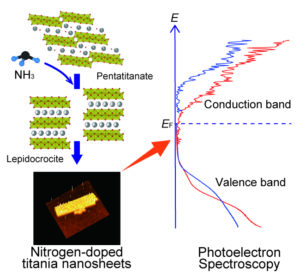
Makoto Kobayashi*, Naoki Hagishima, Eisuke Yamamoto, Minoru Osada*
Abstract
2D semiconducting nanosheets have emerged as versatile platforms for electronics and energy conversion due to their diverse compositions and excellent physicochemical properties. A precise understanding of their electronic structures is essential for optimizing career transport and light energy conversion efficiency; however, experimental insights into the detailed band structures remain limited. In this study, the electronic structures of titanium oxide and nitrogen-doped titanium oxide nanosheets are investigated as a model case. To clarify the effects of nitrogen doping, an alternative precursor is employed that enables the formation of nanosheets with enhanced nitrogen content compared to previously reported methods. The electronic structures of both titania and nitrogen-doped titania nanosheets are elucidated using ultraviolet photoelectron spectroscopy (UPS) and low-energy inverse photoelectron spectroscopy (LEIPS). The results clearly demonstrated that nitrogen incorporation induces both donor level formation and valence band modulation, leading to bandgap narrowing and an upward shift of the Fermi level. These findings provide comprehensive insights into the electronic structures of semiconducting nanosheets and reveal how anion doping modulates their band characteristics.
